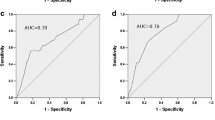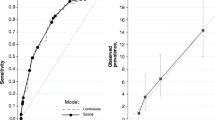Abstract
A risk score model was developed based in a population of 1,224 individuals from the general population without known diabetes aging 35 years or more from an urban Brazilian population sample in order to select individuals who should be screened in subsequent testing and improve the efficacy of public health assurance. External validation was performed in a second, independent, population from a different city ascertained through a similar epidemiological protocol. The risk score was developed by multiple logistic regression and model performance and cutoff values were derived from a receiver operating characteristic curve. Model’s capacity of predicting fasting blood glucose levels was tested analyzing data from a 5-year follow-up protocol conducted in the general population. Items independently and significantly associated with diabetes were age, BMI and known hypertension. Sensitivity, specificity and proportion of further testing necessary for the best cutoff value were 75.9, 66.9 and 37.2%, respectively. External validation confirmed the model’s adequacy (AUC equal to 0.72). Finally, model score was also capable of predicting fasting blood glucose progression in non-diabetic individuals in a 5-year follow-up period. In conclusion, this simple diabetes risk score was able to identify individuals with an increased likelihood of having diabetes and it can be used to stratify subpopulations in which performing of subsequent tests is necessary and probably cost-effective.


Similar content being viewed by others
Abbreviations
- ADA:
-
American Diabetes Association
- AUC:
-
Area under curve
- BMI:
-
Body mass index
- CVD:
-
Cardiovascular diseases
- DBP:
-
Diastolic blood pressure
- EPV:
-
Events per variable
- FPG:
-
Fasting plasma glucose
- HDL-c:
-
High density lipoprotein cholesterol
- IFG:
-
Impaired fasting glycemia
- IGT:
-
Impaired glucose tolerance
- LDL-c:
-
Low density lipoprotein cholesterol
- OGTT:
-
Oral glucose tolerance test
- PCOS:
-
Polycystic ovarian syndrome
- ROC curve:
-
Receiver operating characteristic curve
- SBP:
-
Systolic blood pressure
- T2DM:
-
Type 2 Diabetes Mellitus
References
Incidence of diabetes in the population aged 18–79 Years. Cent Dis Control Prev. 2006. http://www.cdc.go/diabetes/statistics/incidence. Accessed Aug 2006.
Malerbi DA, Franco LJ. Multicenter study of the prevalence of diabetes mellitus and impaired glucose tolerance in the urban Brazilian population aged 30–69 yr. The Brazilian Cooperative Group on the study of diabetes prevalence. Diabetes Care. 1992;15(11):1509–16.
Harris MI. Undiagnosed NIDDM: clinical and public health issues. Diabetes Care. 1993;16(4):642–52.
Ramachandran A, Snehalatha C, Vijay V, Wareham NJ, Colagiuri S. Derivation and validation of diabetes risk score for urban Asian Indians. Diabetes Res Clin Pract. 2005;70(1):63–70.
Glumer C, Carstensen B, Sandbaek A, Lauritzen T, Jorgensen T, Borch-Johnsen K. A Danish diabetes risk score for targeted screening: the Inter99 study. Diabetes Care. 2004;27(3):727–33.
Tunstall-Pedoe H, Kuulasmaa K, Amouyel P, Arveiler D, Rajakangas AM, Pajak A. Myocardial infarction and coronary deaths in the World Health Organization MONICA project. Registration procedures, event rates, and case-fatality rates in 38 populations from 21 countries in four continents. Circulation. 1994;90(1):583–612.
Bisi Molina Mdel C, Cunha Rde S, Herkenhoff LF, Mill JG. Hypertension and salt intake in an urban population. Rev Saude Publica. 2003;37(6):743–50.
Candido AP, Ferreira S, Lima AA, de Carvalho Nicolato RL, de Freitas SN, Brandao P, et al. Lipoprotein(a) as a risk factor associated with ischemic heart disease: Ouro Preto study. Atherosclerosis. 2007;191(2):454–9.
American Diabetes Association. Diagnosis and classification of diabetes mellitus. Diabetes Care. 2008;31(Suppl 1):S55–60.
Pesquisa por amostra de domicílios 2000: microdados. Rio de Janeiro: Fundação Instituto Brasileiro de Geografia e Estatística; 2001.
Alves-Silva J, da Silva Santos M, Guimaraes PE, Ferreira AC, Bandelt HJ, Pena SD, et al. The ancestry of Brazilian mtDNA lineages. Am J Hum Genet. 2000;67(2):444–61.
Ferreira RG, Moura MM, Engracia V, Pagotto RC, Alves FP, Camargo LM, et al. Ethnic admixture composition of two western Amazonian populations. Hum Biol. 2002;74(4):607–14.
Marquezine GF, Oliveira CM, Pereira AC, Krieger JE, Mill JG. Metabolic syndrome determinants in an urban population from Brazil: social class and gender-specific interaction. Int J Cardiol. 2007;129:259–65.
Griffin SJ, Little PS, Hales CN, Kinmonth AL, Wareham NJ. Diabetes risk score: towards earlier detection of type 2 diabetes in general practice. Diabetes Metab Res Rev. 2000;16(3):164–71.
Lindstrom J, Tuomilehto J. The diabetes risk score: a practical tool to predict type 2 diabetes risk. Diabetes Care. 2003;26(3):725–31.
Stern MP, Williams K, Haffner SM. Identification of persons at high risk for type 2 diabetes mellitus: do we need the oral glucose tolerance test? Ann Intern Med. 2002;136(8):575–81.
Tabaei BP, Herman WH. A multivariate logistic regression equation to screen for diabetes: development and validation. Diabetes Care. 2002;25(11):1999–2003.
Spijkerman AM, Yuyun MF, Griffin SJ, Dekker JM, Nijpels G, Wareham NJ. The performance of a risk score as a screening test for undiagnosed hyperglycemia in ethnic minority groups: data from the 1999 health survey for England. Diabetes Care. 2004;27(1):116–22.
Steyerberg EW, Eijkemans MJ, Harrell FE Jr, Habbema JD. Prognostic modeling with logistic regression analysis: in search of a sensible strategy in small data sets. Med Decis Mak. 2001;21(1):45–56.
Laupacis A, Sekar N, Stiell IG. Clinical prediction rules. A review and suggested modifications of methodological standards. JAMA. 1997;277(6):488–94.
Peduzzi P, Concato J, Kemper E, Holford TR, Feinstein AR. A simulation study of the number of events per variable in logistic regression analysis. J Clin Epidemiol. 1996;49(12):1373–9.
Aekplakorn W, Bunnag P, Woodward M, Sritara P, Cheepudomwit S, Yamwong S, et al. A risk score for predicting incident diabetes in the Thai population. Diabetes Care. 2006;29(8):1872–7.
Acknowledgment
This work was supported by Fundação de Amparo à Pesquisa do Estado de São Paulo [grant number 07/54138-2]
Author information
Authors and Affiliations
Corresponding author
Rights and permissions
About this article
Cite this article
Pires de Sousa, A.G., Pereira, A.C., Marquezine, G.F. et al. Derivation and external validation of a simple prediction model for the diagnosis of type 2 Diabetes Mellitus in the Brazilian urban population. Eur J Epidemiol 24, 101–109 (2009). https://doi.org/10.1007/s10654-009-9314-2
Received:
Accepted:
Published:
Issue Date:
DOI: https://doi.org/10.1007/s10654-009-9314-2




